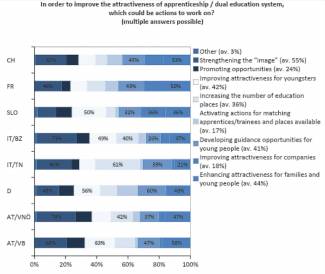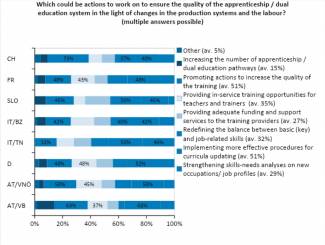Podoba in vrednost dualnega izobraževanja
Nizka javna podoba dualnega usposabljanja nasploh in zlasti rokodelstva se razteza po območjih alpskega prostora. V več državah je mogoče opaziti povečanje akademizacije, ki jo posredno podpirajo šolski učitelji in starši, ki spodbujajo mlade, da si prizadevajo za visokošolsko izobrazbo. Izobrazba tretje stopnje oziroma univerzitetna izobrazba se šteje za jamstvo za varno in dobro plačano službo ter številne poklicne možnosti. Poleg tega obstaja nizek javni ugled nekaterih poklicev oziroma trgovskih panog.

Visibility
As career coach, you could contribute to the visibility of dual education and training by informing your clients about various educational pathways and possibilities for further education as well as career chances. Especially youngsters and their parents, but also teachers, are often not aware of the manifold of existing professions as well as the career chances those are providing. You should encourage your clients to look consciously at their possibilities based on their interests and talents. They also could get better insights into features of various enterprises and benefits of an apprenticeship there by visiting training and career fairs as well as open house days of companies.
Awareness rising
Beside the recommendations above, potential apprentices would also benefit from direct confrontation with the fruits of different training-companies in their region. Maybe enterprises could provide some material for your clients to promote their work and its meaning, for example products made for elderly’s support in everyday life or reports of apprenticeship competitions
Key results from the SME needs assessment within DuALPlus
In spite of their different dual education systems, the partner regions partly struggle with similar challenges, which give insights in SMEs’ needs in the Alpine Space. While representatives of companies emphasized the link of theoretical and practical learning, the possibility of an earlier entry in the labour market as well as of gaining work experiences and sense of responsibility at a younger age as positive aspects respectively strengths of dual education, they also referred to several critical issues and weaknesses. In the following, the key results are presented from a transnational point of view.
1. Data on image and the value of apprenticeships
In the questionnaires as well as in the expert interviews image problems of dual education in the Alpine Space were frequently discussed. The value of particularly vocational training in crafts seems to be underestimated in the partners’ regions: parents and youngsters prefer higher educations. Considering this issue, the SMEs’ representatives were asked which could be actions to work on to improve the attractiveness of dual education.
The priority actions are similar in the partner’s regions. The strengthening of the image respectively value of dual education (average 55%) goes hand in hand with enhancing the attractiveness of dual education for families and young people (average 44%) as well as improving the attractiveness for the youngsters (average 42%) in particular. The participants made a few suggestions for possible actions to increase the attractively of dual education, such as the enabling of possibilities of vocal training in combination with higher education (e.g. high school diploma), higher promotion of job information events and fairs, web portals for dual education formats or vocational orientation (e.g. as school subject) in schools (level 1 respectively 2). Furthermore, it could be promising to work on the guidance for students in the transition between different school levels. Not at least, presentations of success stories as well as case studies of e.g. successful craftswomen or craftsmen could lead to a more positive image of dual education.
Increasing the number of education places is central mainly in the autonomous province Trento (61%), Vorarlberg (42%) as well as in Vienna and Lower Austria (42%). The development of guidance opportunities for young people is an issue especially in Bavaria (60%), France (44%) and Switzerland (43%). Promoting opportunities for dual education is central in particular in Vorarlberg (37%), Bavaria (32%) and Vienna respectively Lower Austria (32%).
Improving the attractiveness for companies to train young people is an issue primarly in Switzerland (37%), Slovenia (36%) and France (28%). Respondents suggested offering SMEs more financial incentives for proposing themselves as training companies.
The following table give an overview of recommended actions to improve the attractiveness of apprenticeship from a transnational perspective in Alpine Space we investigated within the SME needs assessment analysis.

Source: Lime Survey, own computation. AT/VB = Austria/Vorarlberg, AT/VNÖ = Austria/Vienna-Lower Austria; D = Germany/Bavaria, IT/TN = Italy/Trento, IT/BZ = Italy/Bolzano, SLO = Slovenia, FR = France, CH = Switzerland.
2. Data on the quality of the dual education systems
Another issue of the data gathering was the guarantee of dual education and training. To ensure the quality of the dual education system, especially in light of the changes in the production systems and the labour markets, the respondents of the partners’ regions mentioned certain actions to work on.
The priority actions are similar in the partners’ regions. So, the promotion of actions to increase the quality of the training (average 51%) as well as the implementation of more effective procedures for curricula updating (average 51%) are especially relevant in all partners’ regions. Other often mentioned needed actions were providing in-service training opportunities for teachers and trainers (average 35%) as well as redefining the balance between basic (key) and job-related skills (average 32%).
Strengthening skills-needs analyses on new occupations respectively job profiles is central mainly in Trento (46%), Bavaria (40%) and France (39%). Providing adequate funding and support services to the training providers is an issue primarily in Slovenia (41%), Bavaria (32%) and Bolzano (28%). Increasing the number of dual education pathways is central especially in Vorarlberg (32%), Slovenia (18%) and Bavaria (16%).
Other measures included higher financial support of training companies, stronger promotion of training in the regions, revision of school curricula with regard to SMEs’ needs as well as the strengthening of handcraft trades.
The following table gives an overview of recommended actions to ensure the apprenticeship in light of the changes in the production systems and the labour from a transnational perspective in Alpine Space we investigated within the SME needs assessment analysis.

Source: Lime Survey, own computation. AT/VB = Austria/Vorarlberg, AT/VNÖ = Austria/Vienna-Lower Austria; D = Germany/Bavaria, IT/TN = Italy/Trento, IT/BZ = Italy/Bolzano, SLO = Slovenia, FR = France, CH = Switzerland.
3. Data on the improvement of the dual education procedure
To get a full picture of the evaluation and demands of SMEs in the Alpine Space, it was important to take into account issues about the dual education procedure as well as of the cooperation between companies, schools and trainees.
On the average, 60% of the respondents are involved in the final assessment of their trainees, 47% participate in trilateral meetings between companies, schools as well as trainees and 45% are involved in the development of individual training plans

